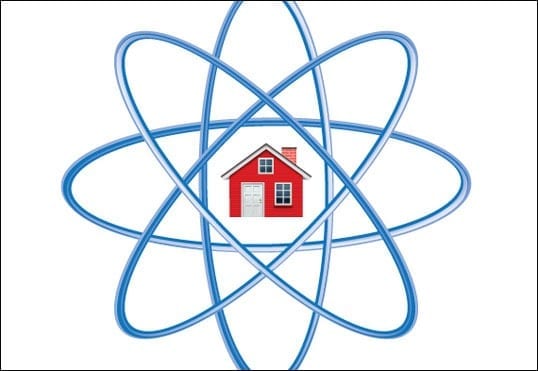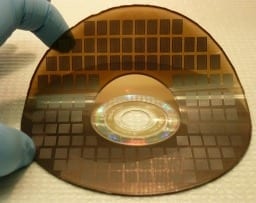
How would you like to replace your water heater with a nuclear reactor?
That’s what Joseph Zawodny, a senior scientist at NASA’s Langley Research Center, hopes to help bring about. It would tap the enormous power of the atom to provide hot water for your bath, warm air for your furnace system, and more than enough electricity to run your house and, of course, your electric car.
If your thoughts have raced to Fukushima or Three Mile Island or Chernobyl, let me reassure you. Zawodny is not suggesting that you put that kind of reactor in your house. What he has in mind is a generator that employs a process called Low-Energy Nuclear Reactions. (The same process is sometimes called Lattice Energy Nuclear Reactions. We’ll just call it LENR.)
So what is LENR and how might it one day fill all your energy needs without risk of blowing up, melting down, or irradiating the neighbors?
Nuclear energy in a nutshell
The nuclear generators which currently provide some of the world’s electricity use a type of fission in which a very heavy nucleus (meaning one with lots of protons and neutrons) such as uranium breaks up into two or more lighter nuclei, releasing energy in the process.
The sun and all the other stars use nuclear fusion, in which two light nuclei (such as those of hydrogen) fuse together in an environment of very high temperature and pressure which overwhelms the mutual repulsion of their positive charges. Again, energy is released in the process—even more than in fission. We know how to use fusion in hydrogen bombs, but so far we lack the technology needed to harness it for more civilized purposes.
In the 1980s, two scientists named Stanley Pons and Martin Fleischmann announced that they had developed a “cold fusion” process that could create fusion through chemical means, without the high temperature or pressure of stars and bombs. There was no theory to explain how that could be possible, and other scientists were unable to reliably reproduce the experiments, so cold fusion lacked credibility for most physicists. Some scientists have continued working on this idea though, and they sometimes call it “LENR.” But this process is not what Dr. Zawodny is exploring.
“There are a lot of people who are trying to just build something without understanding anything,” Zawodny said. “It worked for Edison and the light bulb, but it took him a long time and that was a simple system. This is very complex. And if they make something that just barely works, and accidentally one in a thousand works really, really well, it’s going to take down a house with their trial-and-error method.”
“Several labs have blown up studying LENR and windows have melted,” according to Dennis Bushnell, Langley’s chief scientist, in an article he wrote for NASA’sFuture Innovation website. This, he wrote, indicates that “when the conditions are ‘right’ prodigious amounts of energy can be produced and released.” But it’s also an argument for the approach that the Langley researchers favor: master the theory first.
The epiphany
“For NASA Langley,” according to Bushnell’s article, “the epiphany moment on LENR was the publication of the Widom-Larsen Weak Interaction LENR Theory,” which was published in 2006. According to Zawodny and Bushnell, this theory provides a better explanation than “cold fusion” for the results which researchers have obtained over the last couple of decades. And it might explain much more than that. At a meeting of the American Nuclear Society in November 2012, the theory’s co-developer, Lewis Larsen, speculated that LENR may occur naturally in lightning—not only on present-day Earth, but also in the primordial cloud of gas and dust that became our solar system. If true, LENR might solve a mystery uncovered by NASA’s Genesis mission, that the pattern of oxygen isotopes on the sun differs greatly from that of Earth.
The theoretical underpinnings of LENR are complex, but the basics are pretty easy to understand. Instead of splitting an atomic nucleus apart or ramming two mutually repelling nuclei together, Widom-Larsen’s LENR simply offers a very slow-moving neutron to a nucleus. According to Zawodny, nuclei presented with sluggish neutrons slurp them up like a hungry Texan with a bowl of firehouse chili. But like many a chili consumer, the nuclei can find that their indulgence makes them, shall we say, unstable. And while I am too polite to continue the chili metaphor past this point, the nuclei do find that emissions relieve their distress.
With rare exception, Zawodny said, a nucleus which has lapped up one too many neutrons spits out an electron, which it gets by breaking up one of its neutrons into an electron and proton (and an anti-neutrino, but we can ignore that). So where it once had an extra neutron, making it an unstable isotope of whatever element it was, it now has an extra proton instead, which makes it a more stable isotope of a different element. This process releases energy which, hypothetically, can be used to generate electricity.
The Latest Bing News on:
Low-Energy Nuclear Reactions
- Electricity Newson May 5, 2024 at 5:00 pm
May 1, 2024 — Scientists have dramatically reduced the time and energy required to chill materials to temperatures near absolute zero. Their prototype refrigerator ... Innovation Promises to ...
- Physics newson April 28, 2024 at 5:00 pm
Proximity is key for many quantum phenomena, as interactions between atoms are stronger when the particles are close. In many quantum simulators, scientists arrange atoms as close together as ...
- Excitation of thorium-229 brings a working nuclear clock closeron April 17, 2024 at 5:00 pm
The thorium-doped crystals were only a few millimetres across. They then used a tabletop laser to excite the thorium-229 to the desired low-energy nuclear state. This excitation was confirmed using a ...
- Best air purifiers for allergies 2024on April 15, 2024 at 7:24 am
an associate professor in the Department of Mechanical and Nuclear Engineering at Virginia Commonwealth University, told Live Science. "Examples include dust, pollen, mold, smoke, and airborne bac ...
- Eos Neutrino Detector Pioneering Nonproliferation and Particle Physicson March 27, 2024 at 2:30 am
Neutrinos, elusive particles produced in nuclear reactions ... envisioned to explore high-energy neutrino beams and detect low-energy solar neutrinos and Majorana neutrinos.
- Testing begins on sensitive neutrino detector for nonproliferation and fundamental physicson March 26, 2024 at 6:57 am
Neutrinos and antineutrinos are nearly massless particles produced in many nuclear reactions ... and would have the capacity to search for low-energy solar neutrinos and Majorana neutrinos.
- Power of Lighton October 16, 2023 at 6:17 pm
The gases in the pellet, under the pressure of all this light, will compress to the point where they achieve nuclear fusion ... state to a low-energy state, its atom will emit a photon.
- Nuclear Reactions for Astrophysics Principles, Calculation and Applications of Low-Energy Reactionson August 7, 2023 at 8:32 pm
Beginning with one-channel scattering theory, the book builds up to multi-channel reactions. Emphasis is placed on using transfer and breakup reactions to probe structure and predict capture processes ...
- NASA Claims Cold Fusion Without Naming Iton September 29, 2020 at 6:27 am
Do you remember in 1989 when two chemists announced they’d created a setup that created nuclear fusion at room ... source of electrons to kick off the reaction. Still, this should point the ...
- The DIY Nuclear Reactoron August 6, 2011 at 1:12 am
This attempted experiment is based on one that was done by [David Hahn], AKA, “The Nuclear Boyscout”, in order to obtain his nuclear energy badge. For what it’s worth, [David] did attain ...
The Latest Google Headlines on:
Low-Energy Nuclear Reactions
[google_news title=”” keyword=”Low-Energy Nuclear Reactions” num_posts=”10″ blurb_length=”0″ show_thumb=”left”] [/vc_column_text]The Latest Bing News on:
Lattice Energy Nuclear Reactions
- Nuclear Fusion Breakthroughs Bring Near-Limitless Energy Closeron April 30, 2024 at 5:46 am
Physicists say the discovery offers a potential avenue to "economically attractive fusion energy" in the future.
- What is Fusion, and Why Is It So Difficult to Achieve?on February 22, 2024 at 2:02 am
Today, we know that the sun, along with all other stars, is powered by a reaction called nuclear fusion. If nuclear fusion can be replicated on earth, it could provide virtually limitless clean, safe ...
- Nuclear fusion reaction releases almost twice the energy put inon February 5, 2024 at 9:43 am
Today’s nuclear power plants rely on fission reactions, where atoms are smashed apart to release energy and smaller particles. Fusion works in reverse, squeezing smaller particles together into ...
- Nuclear Fusion: Energy Breakthrough or Ballyhoo?on August 16, 2023 at 6:00 am
Nuclear fusion can theoretically emit so much energy so fast that scientists are still determining how small reactions can be scaled down. Without significant energy grid investment, it is ...
- Fermi creates controlled nuclear reactionon August 13, 2023 at 12:19 pm
The reaction was self-sustaining. The team could increase or decrease the energy output by adjusting the rods. Fermi's idea had worked, and the first controlled, self-sustaining nuclear chain ...
- How to invest in nuclear energy: Adding uranium to your portfolioon September 13, 2022 at 5:00 pm
Nuclear energy is energy created via a fission or fusion reaction of atoms. These reactions produce heat that is then used to generate electricity. While nuclear energy is a clean source of power ...
- Nuclear reactionon October 1, 2021 at 6:16 am
and nuclear reactions can be employed artificially to obtain nuclear energy, at an adjustable rate, on demand. Nuclear chain reactions in fissionable materials produce induced nuclear fission. Various ...
- Nuclear energyon September 14, 2021 at 2:32 pm
This is called a chain reaction. All the splitting atoms release energy in the form of heat. The heat is used to turn water into steam. Nuclear radiation is all around us. It reaches us from space ...
- What is nuclear energy?on July 7, 2021 at 11:14 am
This is called a chain reaction. All the splitting atoms release energy in the form of heat. The heat is used to turn water into steam. Nuclear radiation is all around us. It reaches us from space ...
- The first nuclear reactor, explainedon May 21, 2021 at 5:10 am
In 1942, the Manhattan Project needed to create a chain reaction—a crucial ... Pile-1,” the world’s first nuclear reactor kicked off the Atomic Age and has a complicated legacy, including the rise of ...
The Latest Google Headlines on:
Lattice Energy Nuclear Reactions
[google_news title=”” keyword=”Lattice Energy Nuclear Reactions” num_posts=”10″ blurb_length=”0″ show_thumb=”left”]










